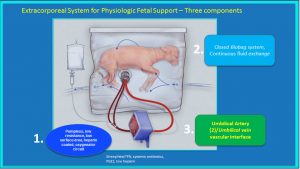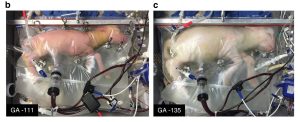Miten erilaisesti sama uutinen voidaan kirjoittaa, tässä hyvä esimerkki. Professionaalinen, hatunnostonarvoinen saavutus. Tosin kyllä Verge tässä veti mielestäni pidemmän korren.
”An artificial womb successfully grew baby sheep — and humans could be next
The lambs spent four weeks in the external wombs and seemed to develop normally
by
Inside what look like oversized ziplock bags strewn with tubes of blood and fluid, eight fetal lambs continued to develop — much like they would have inside their mothers. Over four weeks, their lungs and brains grew, they sprouted wool, opened their eyes, wriggled around, and learned to swallow, according to a new study that takes the first step toward an artificial womb. One day, this device could help to bring premature human babies to term outside the uterus — but right now, it has only been tested on sheep.
It’s appealing to imagine a world where artificial wombs grow babies, eliminating the health risk of pregnancy. But it’s important not to get ahead of the data, says Alan Flake, fetal surgeon at the Children’s Hospital of Philadelphia and lead author of today’s study. “It’s complete science fiction to think that you can take an embryo and get it through the early developmental process and put it on our machine without the mother being the critical element there,” he says.
Instead, the point of developing an external womb — which his team calls the Biobag — is to give infants born months too early a more natural, uterus-like environment to continue developing in, Flake says.

The Biobag may not look much like a womb, but it contains the same key parts: a clear plastic bag that encloses the fetal lamb and protects it from the outside world, like the uterus would; an electrolyte solution that bathes the lamb similarly to the amniotic fluid in the uterus; and a way for the fetus to circulate its blood and exchange carbon dioxide for oxygen. Flake and his colleagues published their results today in the journal Nature Communications.
Flake hopes the Biobag will improve the care options for extremely premature infants, who have “well documented, dismal outcomes,” he says. Prematurity is the leading cause of death for newborns. In the US, about 10 percent of babies are born prematurely — which means they were born before they reach 37 weeks of pregnancy. About 6 percent, or 30,000 of those births, are considered extremely premature, which means that they were born at or before the 28th week of pregnancy.
These infants require intensive support as they continue to develop outside their mothers’ bodies. The babies who survive delivery require mechanical ventilation, medications, and IVs that provide nutrition and fluids. If they make it out of the intensive care unit, many of these infants (between 20 to 50 percent of them) still suffer from a host of health conditions that arise from the stunted development of their organ systems.
It’s “complete science fiction” to think you could do this without the mother
“So parents have to make critical decisions about whether to use aggressive measures to keep these babies alive, or whether to allow for less painful, comfort care,” says neonatologist Elizabeth Rogers, co-director for the Intensive Care Nursery Follow-Up Program of UCSF Benioff Children’s Hospital, who was not involved in the study. “One of the unspoken things in extreme preterm birth is that there are families who say, ‘If I had known the outcome for my baby could be this bad, I wouldn’t have chosen to put her through everything.’”
That’s why for decades scientists have been trying to develop an artificial womb that would re-create a more natural environment for a premature baby to continue to develop in. One of the main challenges was re-creating the intricate circulatory system that connects mom to fetus: the mom’s blood flows to the baby and back, exchanging oxygen for carbon dioxide. The blood needs to flow with just enough pressure, but an external pump can damage the baby’s heart.
To solve this problem, Flake and his colleagues created a pumpless circulatory system. They connected the fetus’s umbilical blood vessels to a new kind of oxygenator, and the blood moved smoothly through the system. Smoothly enough, in fact, that the baby’s heartbeat was sufficient to power blood flow without another pump.
For decades, scientists have been trying to develop an artificial womb
The next problem to solve was the risk for infections, which premature infants in open incubators face in the neonatal intensive care unit, or NICU. That’s where the bag and the artificial amniotic fluid comes in. The fluid flows in and out of the bag just like it would in a uterus, removing waste, shielding the infant from infectious germs in the hospital, and keeping the fetus’s developing lungs filled with fluid.
Flake and his colleagues tested the setup for up to four weeks on eight fetal lambs that were 105 to 120 days into pregnancy — about equivalent to human infants at 22 to 24 weeks of gestation. After the four weeks were up, they were switched onto a regular ventilator like a premature baby in a NICU.
The lambs’ health on the ventilator appeared nearly as good as a lamb the same age that had just been delivered by cesarean section. Then, the lambs were removed from the ventilator and all but one, which was developed enough to breathe on its own, were euthanized so the researchers could examine their organs. Their lungs and brains — the organ systems that are most vulnerable to damage in premature infants — looked uninjured and as developed as they should be in a lamb that grew in a mother.
Of course, lambs aren’t humans
Of course, lambs aren’t humans — and their brains develop at a somewhat different pace. The authors acknowledge that it’s going to take more research into the science and safety of this device before it can be used on human babies. They’ve already started testing it on human-sized lambs that were put in the Biobags earlier in pregnancy. And they are monitoring the few lambs that survived after being taken off the ventilator to look for long-term problems. So far, the lambs seem pretty healthy. “I think it’s realistic to think about three years for first-in-human trials,” Flake says.
“It’s so interesting, and it’s really innovative,” Rogers says. “To be able to continue to develop in an artificial environment can reduce the many problems caused by simply being born too early.” Rogers adds that not every facility has the resources or expertise to offer cutting-edge care to expecting mothers — a problem that the Biobag won’t be able to solve. “We know there are already disparities after preterm birth. If you have access to high-level regionalized care your outcomes are often better than if you don’t,” she says.
“I’m still blown away, whenever I’m down looking at our lambs.”
And Rogers worries about how hype surrounding the Biobag could impact parents coping with preterm infants. “I think many people have been affected by preterm birth and they think this is going to be some magic bullet. And I think that prematurity is just really complicated.” Preventing it in the first place should be a top priority, she says, but the Biobag could help drive that research forward.
For Flake, the research continues. “I’m still blown away, whenever I’m down looking at our lambs,” he says. “I think it’s just an amazing thing to sit there and watch the fetus on this support acting like it normally acts in the womb… It’s a really awe-inspiring endeavor to be able to continue normal gestation outside of the mom.
This post has been updated with video.” Verge
”Testi onnistui: Karitsat kasvoivat muovipusseissa viikkoja ennen syntymää – keinokohtu voi auttaa keskosiakin
Biopussissa kasvatetut karitsat kehittyivät normaalisti. Suomalaisasiantuntija: Voi olla tärkeä seuraava askel keskosten hoidossa.
Yhdysvalloissa on kehitetty keinokohtu, jolla pystytään tulevaisuudessa ehkä pitämään hengissä aivat pienetkin keskoset.
Keinokohtua on testattu onnistuneesti lampailla Philadelphian lastensairaalassa. Testissä käytettiin lampaita, koska niiden keuhkot kehittyvät hyvin samaan tapaan kuin ihmisellä.
Karitsat, joita oli kaikkiaan kuusi, siirrettiin lapsivedellä täytettyyn biopussiin vain muutamia minuutteja sen jälkeen, kun ne oli leikattu ulos emostaan. Raskaus oli tuolloin edennyt yhtä pitkälle kuin ihmisellä 23 viikon jälkeen. Sikiöiden napanuorat liitettiin tekoistukoihin, jotka hapettivat niiden verta. Sikiöt saivat myös tarvitsemansa ravinteet tätä kautta.
Eläimet kehittyivät aivan normaalisti niiden viikkojen aikana, jotka ne viettivät läpinäkyvässä biopussissa. Osa eläimistä kasvoi pussissa jopa neljä viikkoa. Sinä aikana ne kehittyivät karvattomista ja vaaleanpunaisista sikiöistä vastasyntyneiden näköisiksi.
Biopusseissa kasvaneista lampaista vanhin on nyt yli vuoden ikäinen, ja se vaikuttaa kehittyneen täysin normaalisti.
Keskosten hoito kehittynyt, mutta ongelmia riittää
Ihmisellä keskosina pidetään lapsia, jotka syntyvät 22. raskausviikolla tai sen jälkeen.
Viime vuosikymmeninä keskosten hoito on kehittynyt niin, että jopa noin 23. raskausviikolla syntyneet lapset pysyvät hengissä. Ongelmana on, että monet heistä kärsivät vakavista ja pysyvistäkin terveysongelmista.
23. viikolla syntyneet keskoset painavat hieman yli puoli kiloa, heidän silmänsä ovat vielä kiinni, ohut iho on punertava ja verisuonet näkyvät sen lävitse. Myös keuhkot ovat kehittymättömät, ja siksikin lapsia pidetään keskoskaapeissa.
Tutkijat uskovat, että uusi keinokohtu voi helpottaa merkittävästi sellaisten keskosten selviämistä, jotka eivät vielä hengitä, kykene syömään ravintoa tai vastustamaan infektioita. Tutkimusta johtaneen Alan W. Flaken mukaan uusi menetelmä luo kipeästi kaivatun sillan tärkeiden viikkojen yli.
– Jos kykenemme tukemaan kasvua ja elinten kehitystä vain muutaman viikon ajan, voimme parantaa huomattavasti hyvin ennenaikaisesti syntyneiden lasten selviytymistä, sanoo Flake.

Hyväksytäänkö ihmissikiön kasvattaminen biopussissa?
Philadelphialaistutkijat vakuuttavat tiedostavansa mielikuvaongelman, joka liittyy uuteen teknologiaan.
Flake korostaa, ettei halua ihmisten näkevän menetelmää sellaisena, että ”ihmisiä roikkuu seinillä muovipusseissa”. Laite ei näytä sellaiselta, eikä toimi niin, hän vakuuttaa.
Ihmisversio muistuttaa nesteellä täytettyä keskoskaappia, joka on sekä pinnalta että sisältä tumma. Siellä olevaa keskosta seurataan kameroilla.
Flake ei myöskään hyväksy näkemystä, joka mukaan laite muistuttaisi kirjailija Aldous Huxleyn luomaa ”uutta uljasta maailmaa”, jossa lapsia tuotetaan maailmaan keinotekoisilla kohduilla. Sellaista teknologiaa ei ole olemassa ja ainoastaan äiti pystyy varmistamaan sikiön selviämisen raskauden alkuvaiheessa, Flake korostaa.
Hänen mukaansa keskosten hoito keinokohdulla voi olla mahdollista jo vuosikymmenen kuluttua.
Tutkimus on julkaistu. Siitä uutisoivat muun muassa ja
Suomalaisasiantuntija: ”Hatunnostonarvoinen saavutus”
Husin sikiölääketieteen keskuksen osastoylilääkäri, professori Juha Räsänen kuvailee yhdysvaltalaistutkijoiden saavutusta hatunnoston arvoiseksi. Räsänen on aiemmin työskennellyt Alan W. Flaken kanssa ja kertoo tämän puskeneen keinokohtuideaansa läpi pitkään ja sinnikkäästi.
Räsäsen mukaan äitinsä kohdussa olevaan sikiöön on aiemminkin osattu laittaa kanyyleja napasuoneen kohdun sisälle. Sitä kautta sikiölle on annettu ravintoaineita. Tämä on ollut ”biologisempi malli” nyt kehitteillä olevasta, hän sanoo.
Perinteisillä keinoilla aletaan kuitenkin olla rajoilla sen suhteen, kuinka varhaisessa vaiheessa sikiöitä voidaan synnyttää ja hoitaa. Räsänen sanoo toivovansa, että Philadelphiassa kehitetty hoito on tulevaisuudessa todellisuutta.
– Tämä voisi olla seuraava tärkeä askel. Siihen on kuitenkin vielä pitkä matka, Räsänen sanoo.
Ongelmia voi tuottaa vielä esimerkiksi se, että lampaiden ja ihmisten elinten kehitys ei ole aivan samanlaista. Lampailla keuhkotkin kehittyvät vähän myöhemmässä vaiheessa raskautta. Myöskään esimerkiksi aivojen osalta kehitys ei ole analogista.
Räsäsen mielestään seuraavaksi olisi paikallaan tehdä kokeita jollain ihmistä lähempänä olevalla eläimellä, esimerkiksi apinalla.
Eikö sikiö kaipaa esimerkiksi äitinsä sydämen ääniä, jos hänet on siirretty biopussiin?
– Kyllä varmaan lapsi kaipaa virikkeitä. Me emme vielä ymmärrä tarkkaan lapsen ja äidin psykologista suhdetta raskauden aikana.
Toisaalta jo nykyisin lapsi siirretään kohdusta lääkäreiden hoidettavaksi 24-viikkoisena, hän muistuttaa.
Räsänen toivoo, että biopussiin voitaisiin tulevaisuudessa suhtautua yhtenä hoitona muiden hoitojen rinnalla. Mitään eettisiä ongelmia hän ei siinä näe.
– Eihän kukaan yritä lähteä äitiä korvaamaan. Ihmiselle tai mille tahansa eläinlajille oman ädin kohdun sisällä oleminen raskauden loppuun asti on kuin lottovoitto, hän sanoo.” YLE